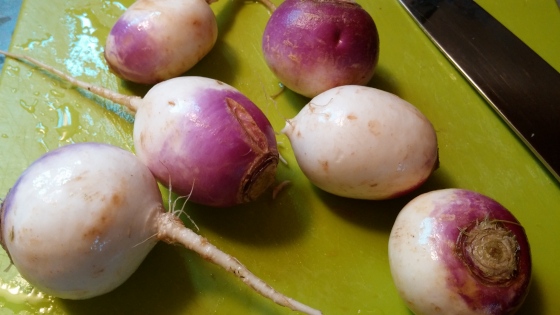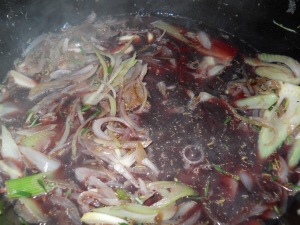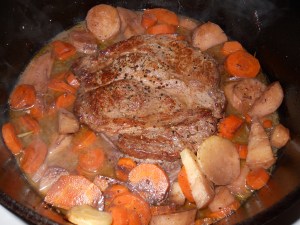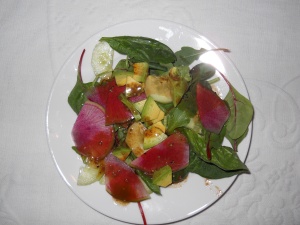My parents are visiting from Southern California this weekend and it’s so good to see them! We share our love of food, so their trips to Portland always include some culinary adventures. When my father was growing up, he worked as the butcher in my grandfather’s grocery store. Nothing makes my Midwestern-born dad happier than tender, perfectly cooked meat with a side of potatoes. That said, my love of cooking—not just eating—definitely began with my mother. She indulged my quest to find the perfect lemon bar recipe and praised my brownies to anyone who would listen (my secret is olive oil.)
We were one of the few families that ate a home-cooked meal together every night when I was a kid. As I got older and my celiac symptoms worsened, our shared meals were layered with the anxiety of whether or not I would get sick. Now that I’m healthy we don’t spend too much time reliving my illness, but when we do it’s clear how traumatic the experience was for all of us. What I learned from my experience is that it’s hard to watch someone you love suffer. The people around me struggled in their own ways.
Without a diagnosis, it was hard to understand what was happening. It’s human nature to search for the cause of the problem and try to fix it. Because that wasn’t possible, the only thing left to do was be with me in my sickness. Unfortunately chronic illness is cyclical—I could identify the early symptoms that a severe period of illness was coming, but I didn’t know how to stop it. The repetition became familiar to those closest to me, but for me it became more and more terrifying.
Accepting that no one had control over my illness was difficult. When a doctor couldn’t find anything wrong with me, he suggested I see a psychiatrist (and I did!) I’m not alone in this. The American Autoimmune Related Diseases Association conducted research that showed that “45 percent of patients with autoimmune diseases have been labeled chronic complainers in the earliest stages of their illness.” The AARD attributes this to the fact that the majority of people with autoimmune disease are young, healthy looking women. Everyone agreed I should be healthy, so if I took the tests and the medications and followed my doctor’s orders but was still getting sick, I must be the one doing something wrong. Of course my family and friends knew I didn’t want to be sick, but sometimes their questions (“What did you eat?” “Did the doctor say you can do that?”) left me feeling responsible for my illness.
It was my naturopath, Dr. Hudson, who finally believed my experience of being sick. After hearing my story she suggested we test for celiac and food allergies, and so began the path to healing. Looking back, I am so grateful for the family and friends who supported me in a myriad of ways. It’s one thing to spend hours in an emergency room with an ill friend, and it’s another thing to do it every month like clockwork. And I hold a special place in my heart for those who could just be with me in my illness and watch me suffer. It takes courage to accept that we don’t have control, and that we can’t understand why this is happening. Those who could face that reality inspired me to be brave and to keep trying to get better.
Chronic illness doesn’t have a linear progression. Just as the cycle of my symptoms felt like a downward spiral, my experience of healing has been a gradual move from the dark center into the light. Now I feel healthy most of the time, and although setbacks are discouraging, at this point they are rare. I can linger over a meal with my parents as we watch the late summer evening turn to dusk. I can sit back in my chair full and satisfied, and suggest we go for ice cream.

Our Saturday evening meal was Grilled Beef Tenderloin with Asparagus and Slivered Potatoes. Served with our friend Pat and Leigh’s Dominio IV Temperanillo and topped off with ice cream from Salt and Straw. There are no recipes for this post—the meat is seasoned with salt and pepper then grilled to medium rare. The asparagus is drizzled in olive oil and sea salt and grilled to a light char. The potatoes (red and yellow) are slivered with some yellow onion, drizzled in olive oil and doused liberally with salt and pepper, then grilled in a foil packet until done. This is Midwestern cooking, California style!
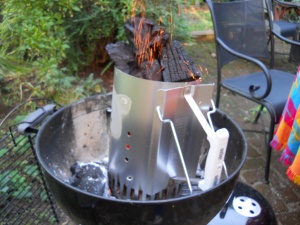



Check back for two more recipe-focused posts this week!

